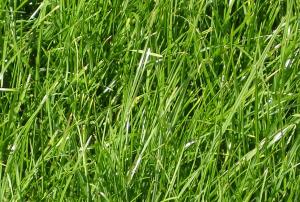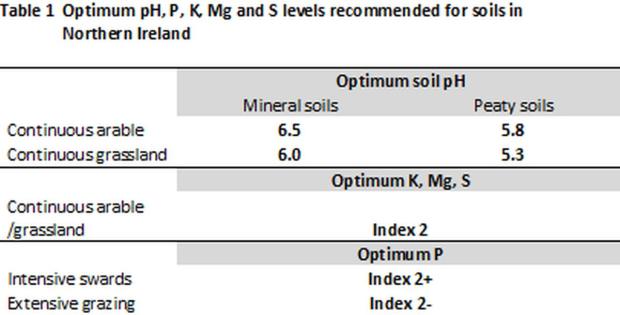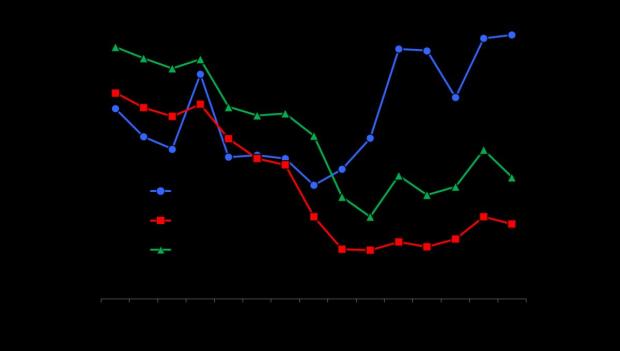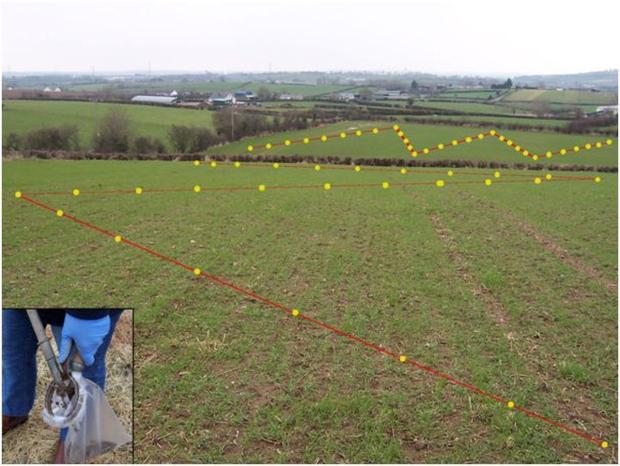AFBI research shows soil testing pays dividends
Date published:
AFBI research shows that investing in soil analysis is the best financial investment a farmer can make. An initial outlay of £7-10 per field (depending on analysis), has the potential to unlock hundreds or thousands of pounds through more efficient use of fertilizers, better grass and crop quality and increased productivity.

Soil Fertility


Maintaining soil at optimum fertility levels for grass or crop growth is the key for profitable farming. This has become increasingly difficult with greater intensification, higher stocking rates and extended grazing periods all within the context of a highly variable climatic background.
Optimum fertility levels for soil nutrients and trace elements for crops growing in Northern Ireland are highlighted in Table 1.
Considerable changes have taken place in terms of nutrient input to the soils of Northern Ireland since 2000, largely driven by cost and environmental legislation. As Figure 1 illustrates, sales of Phosphorus (P) and potassium (K) have fallen considerably over this period, although a slight increase can be observed from 2009. A more pronounced increase in the use of lime is evident from 2007, with sales doubling to 170,000 t in 2014. However, a survey conducted in 2014/15 by AFBI of over 500 field sites in Northern Ireland found that of the grassland fields sampled, the following percentages were below the optimum levels:
pH 64%
Phosphorus (P) 25%
Potassium (K) 32%
 Soil pH
Soil pH

Soil pH is the most important consideration in managing soils for plant growth. Although ryegrass will grow over a range of pH levels, it will grow best between pH 6.0 and 6.5. Keeping a soil at this optimum level also helps maintain the integrity of the ryegrass sward reducing competition from less productive grasses. Soil acidity (pH), rarely affects the growth of most crops directly (in the range 5.5-7.5). It can however have significant influence on the plant availability of other nutrients. At levels below pH 6.0, P tends to form compounds which are unavailable to plants. In soils with pH less than 5.5 the availability of P in soil solution is reduced by 30 percent or more. Acidic soils also reduce root growth potential, which is of course critical for P and other nutrient uptake. In such a situation applying P fertilizer without adjusting the pH would be highly inefficient with a significant proportion of the applied P being unavailable to the plant, but being potentially available as an environmental pollutant.
Soil Nutrient index
Soil analysis reports the level of the measured plant available nutrient in terms of an Index range. As Table 1 indicates, Index 2 is considered the optimum for nutrients in the majority of grassland and arable enterprises. At Index 2, a maintenance application only is required – replacing those nutrients removed in the crop, milk, meat etc (this may be met through applications of slurry or manure, particularly as concentrate input, to dairy farms especially, has increased in recent years). A plant growth response to additional nutrient input would only be likely for soils reporting Indexes 0 or 1. In cases of Index 3 or higher, such soils should remain productive without further application of the specific nutrients until they revert to Index 2, where a maintenance application should again be applied.
Should I Soil Sample?
In Northern Ireland, sampling an intensive grassland or arable field once every 4 years will provide sufficient accuracy to allow meaningful fertiliser/nutrient application recommendations. More frequent sampling may be required with specific soil types eg free draining (nutrient leaching), or specific enterprises (horticulture).
The Nitrates Action Programme also identifies 2 situations where soil sampling is required:
- Application of a chemical fertilizer containing P can only be carried out if a crop need has been demonstrated through a soil test.
- From the 1st January 2017 application of organic manures containing more than 0.25 kg of total P per 1 kg of total N, can only be applied if a crop need has been demonstrated through a soil test. The purpose is to prevent the over application of phosphorus. This is a problem if manures containing a high proportion of phosphorus are applied in line with crop requirement for nitrogen.
Soil Sampling
Care should be taken in the sampling process as analytical results will only be meaningful if an adequate and representative soil sample is taken. Soil sampling should be carried out during the winter or early spring period, leaving the longest possible time interval between sampling and the last lime, fertiliser or manure application - preferably at least 2 months.
Ideally a single soil sample should represent an area of uniform soil conditions and crop management and cover a maximum area of no more than 4ha (10 acres). For example if a field of 4ha (10 acres) size contained two contrasting soils types, sandy loam on a sloping hill and deep alluvium on the flat bottom, then 2 separate soil samples would give the most meaningful results.

In all situations, the most representative sample can be obtained from the chosen area by adopting a ‘w’ layout pattern (see Figure 2) where ideally up to 20 separate cores are taken to the required depth and bulked together to give a total sample weight of between 0.5 and 1kg. This sample should then be labelled with the appropriate details, and additional information provided on details such as previous crop history to ensure that the recommendations returned are as accurate as possible
Benefits
The AFBI survey of current soil nutrient levels across Northern Ireland indicates that there is significant potential to improve agricultural productivity, with 64% of grassland sites being below the optimum pH 6.0 for mineral soils. Adjusting soil pH by lime application has the benefit of both, mineralizing nutrients currently locked in the soil, and making more efficient use of nutrients applied as either chemical fertilizer or as slurry or manure.
Notes to editors:
AFBI carries out high quality technology research and development, statutory, analytical, and diagnostic testing functions for DARD and other Government departments, public bodies and commercial companies.AFBI's Vision is “Scientific excellence in Northern Ireland … serving the world”.All media enquiries to AFBI Press Office